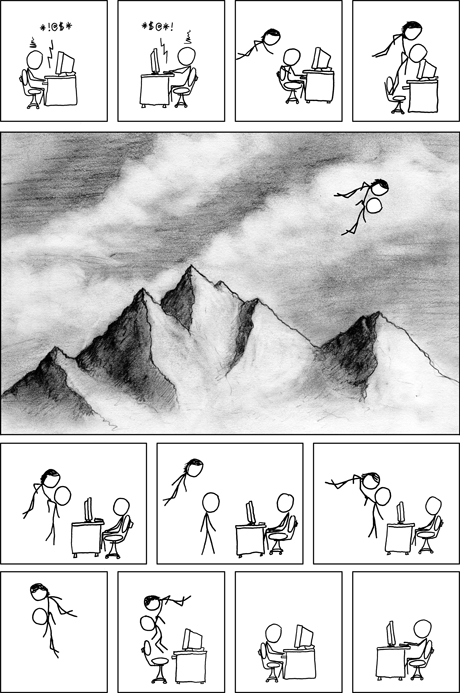New Media, Old Media, and Getting Beyond Scapegoating in the Pro-Life Movement
In reaction to John Bentley May’s article in the Catholic register about the Salt and Light Television / LifeSiteNews.com controversy within the pro-life movement, Dorothy Cummings McLean has an article of her own filled with honesty and insight about the situation.
This morning I woke up at five, feeling sick. Today I want to defend pro-lifers without worsening the battle between fans of Fr. Thomas Rosica and fans of LifeSiteNews. I’m not sure how to do that, and it seems so important.
[…]
When I look at all the combatants in the recent fuss over Fr. Rosica’s intemperate blogpost attacking the intemperance of pro-life leaders, I see a lot of good people. Fr. Rosica is a good man with a wonderful television station that offers Christians educational and spiritual programs. John-Henry Westen is a good man with a popular web site that offers social conservatives stories and viewpoints they won’t find in the mainstream media. John Bentley Mays is a good man writing from the viewpoint of a recent convert to Catholicism. Then there are those who were disappointed when the archdiocese of Boston sanctioned a hero’s funeral for pro-choice Ted Kennedy, complete with a eulogy from pro-choice U.S. President Barack Obama. They’re probably good people, too, when they’re not losing it on Fr. Rosica’s answering machine.
Well said.
I have often criticized the pro-life movement… I have muttered about public relations morons. I have written against the use of gory photographs of mutilated aborted babies. But I have been infuriated when I read in the papers, again and again, that pro-lifers are “anti-choice” and “extremists.” And I never thought to see the word “extremist” applied to non-violent pro-lifers in The Catholic Register, as I did last week.
Glad to see I wasn’t the only one surprised by the term “extremist.”
But her conclusion in the end about one of the causes of the problem surprised me:
There is something new going on in the Canadian Catholic community, and it is stirring us up. I’m not referring to abortion, which is something we have strived against since 1969. I am referring to the new media revolution. The old media of print and television are being displaced by the new media of the Internet. Now instead of being restricted to writing letters to the editor, anyone can be an editor. And this is making those used to the old media very nervous.
I think it’s a very important observation, but I’m not sure she’s drawing the right conclusions.
First of all, who’s new media and who’s old media with respect to LifeSiteNews.com and Salt and Light? LifeSiteNews.com is a web-based news service without an RSS feed (in 2009!), while Salt and Light runs an active blog (which… I just realized uses the same WordPress theme as we do), webcasts their video feed, and is even active on Twitter. There’s no clear old / new media divide here.
But I think there’s a bit of Here Comes Everyone going on here. It’s much easier for anyone to have their say. Meaning, it’s a lot easier to get carried away when anger builds up collectively online, as opposed to everyone just shouting at their television sets in the privacy of their own homes.
This can be a good thing, if it means mobilization and opposition against real moral wrongs (like the movement against Bill C-384 in Canada now). But it’s also dangerous when it comes to scapegoating and in-fighting.
Everyone needs a little more xkcd in their lives:


Thanks for the shout-out, Blaise! As a matter of fact, the Catholic Register (which has been around for over a hundred years) has a website, too.
You make a good point about Salt + Light having its own online presence now, and since no-one I know subscribes to Salt + Light TV, I’ve only ever seen it on the internet. But it is endorsed by the CCCB, just as the Catholic Register is endorsed by the Archdiocese of Toronto. And I am fine with that: some Catholic media does need to have the seal of approval from church authority. The Catholic Register and Salt + Light draw some of their credibility because of clerical endorsement. And this is very traditional and even “old (Catholic) media” although certain segments of “old (Catholic) media” ran counter to episcopal authority: the now-defunct Catholic New Times comes to mind.
But what we are seeing now is a communications revolution in that anyone and everyone can set up a blog and begin writing on Catholic issues. And depending on the material presented or the skill in presenting it, anyone can attract a large following. No endorsement from the bishops is demanded or even expected by the readers. This leaves the bishops–and traditional media power structures–in a situation akin to the invention of the printing press.
I have no idea how much of a player either Salt + Light or The Catholic Register is on the “Catholic blogosphere.” My guess is that their readerships are dwarfed by the readership of such blogs as “LifeSiteNews”–which has a large American following–“What Does the Prayer Really Say” and “American Papist”. From a Girardian perspective, such blogs have something that old media might want: huge readerships and fervent fans. Meanwhile, old media have something bloggers might want: funding and credibility. These longings might be setting up what Girard calls “mimetic rivalry.”
How to respond to the Catholic (or “Catholic”–LifeSiteNews doesn’t claim to be Catholic, so far as I know) blogosphere? Looking at the popularity of “Father Sean’s Blog”, the blog of Boston Cardinal O’Malley, it might be a good idea for the CCCB to begin their own blogs or endorse their favourite blogs. The dream of an episcopal stamp of approval (or even funding) might inspire some bloggers to mind their manners. What I hope the Canadian bishops do, in their October plenary, is talk to experts in the new media, and that includes lay stars of the new media, not just experts on TV and print. I also hope they talk to somebody (anybody!) from the “disgruntled conservative” side of things.
All the best, and my love to U of T Students for Life. I was President of U of T Pro-Life (or the Media Spokeswoman, I forget now) many moons ago.
Dorothy, thanks for the comment!
(The Catholic Register has a great website too! Impressed with the use of a Creative Commons license, and the website is so useful that I don’t subscribe to the paper anymore — perhaps a different conversation 😉
I agree with you much more, having seen the long form of the argument. I guess the confusing part in the short form is that old vs new media often refers to old/new technology (blogs vs newspapers, YouTube vs TV, etc), but I think you meant it more in terms of structures of organization (or lack thereof).
In Here Comes Everyone, Clay Shirky focuses on Voice of the Faithful when talking about the Catholic Church… It’s one thing when you’re dealing with a group that doesn’t have many pretenses about being faithful to the Magisterium or that has little use for approval from the Church authority. But it’s a much more complicated matter when dealing with well-meaning folks who take Church authorities quite seriously, but are operating without any particular endorsement or official oversight.
Very interesting. I always enjoy reading your articles — thanks for stopping by! (And that’s really cool that you were involved with our group in the past!)
Thanks, Blaise! Hmm…dropping your subscription to read the online version for free…? I don’t know if my editor would like that. How to make money from publishing through the internet is definitely a whole other (but important) issue!
I can see how the old/new tech terminology can muddy the issue. (And I could have been more clear!) The issue is really one about established media power vs new media power, whatever the medium–only now, of course, the medium is the internet blog. VOF is an interesting parallel because it has priests in it, just as priests (like Father Z) are becoming internet stars, with hundreds or even thousands of fans. How annoying it must be for people who worked hard through the old cursus honorum (like a degree in journalism at Ryerson) to get their place at the media table to see themselves playing second-banana to some guy with a computer, time on his hands, and a way with words!
Our version of your group used to have in info table at Sidney Smith. Man, we got a lot of abuse, although it was nothing like what we saw recently at McGill. Take care!
Re: Catholic Register: My family’s subscription just recently expired. My parents weren’t sure whether or not to renew (I was one of the major readers, but I access it via RSS now). I convinced them to send in a donation equal to the subscription cost instead of just letting it slide (or renewing without much use for the paper). 😉
Re: Students for Life: We can get our fair share of abuse sometimes, though we’ve been lucky over the past few years not to have any real attempts at censorship (compared to what’s happened at Lakehead, Guelph, McGill, Carleton, etc…).